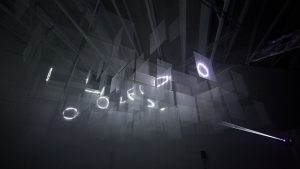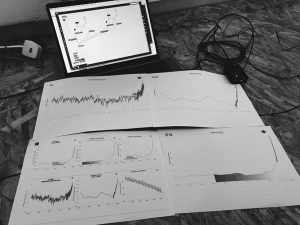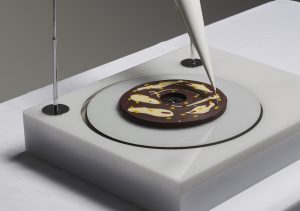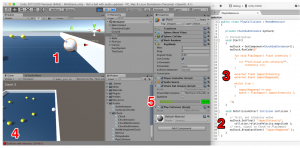For this assignment, I shopped around a lot and looked at a variety of sound and new media artists to see what caught my eye. There was some really astounding work in a wide range of forms, such as computing sound into visual representation, or using computer programming to form sounds out of things that don’t generally create it. It reminded me of a podcast I listened to awhile ago that talked about being able to identify noises that were playing in the background of silent videos simply because of the way the objects appear. Computers were used to detect tiny movements and vibrations in the frames, and used it to bring out people’s voices. I thought that was not only crazy interesting, but also a possible window into making artwork that reflects on the past.
And speaking of reflecting on the past, the artist that really caught my eye, Robert Henke, combined engineering and sound to document a past tragedy in a beautiful way. In his audiovisual laser installation, “Fall” (2016), he was inspired by the village in southern Bavaria of the same name that disappeared underwater in the 1950’s after a reservoir was built. Henke, a German-based artist who creates mainly installation combinations of contemporary electronic music and laser work, was inspired when the ruins of this village resurfaced in 2015, and created a hanging sound installation that completely engrossed me as soon as I watched the video (above).
The installation is made of hanging fabric structures, which are distributed by an algorithm Henke created. This is one thing that I think really defines this artist as a new media computer artist: he generates algorithms for almost every installation and sound he creates, and in this way his work is very technical but very individual. Lasers are used to illuminate the translucent and pieced-together build of the fabric construction, and an entire show plays through in about 10 minutes, varying in color and texture to create a water-like effect on the ceiling.

The sound that plays is particularly interesting. Henke generated his own track of music that is of course algorithm based, and it sounds kind of like a jungle mixed with clinking glass layered on top of static or big noises or something– I can’t describe it, but it’s somehow very electronic and very organized all at the same time, and very interesting ot listen to. The lasers are also punctuated by some larger noises, and every movement is matched with sounds or electronic percussion somehow.
I have no idea how he generated algorithms as complex as those he used to make these noises. I know that there is defiantly code that relates the movements of the lasers to the beat of the track he created, and since the tempo seems to be constantly changing as the pace ebbs and flows (like water). I especially wonder how he can achieve sounds that feel so organic and natural with technical algorithms.
![[OLD FALL 2018] 15-104 • Introduction to Computing for Creative Practice](../../../../wp-content/uploads/2020/08/stop-banner.png)




